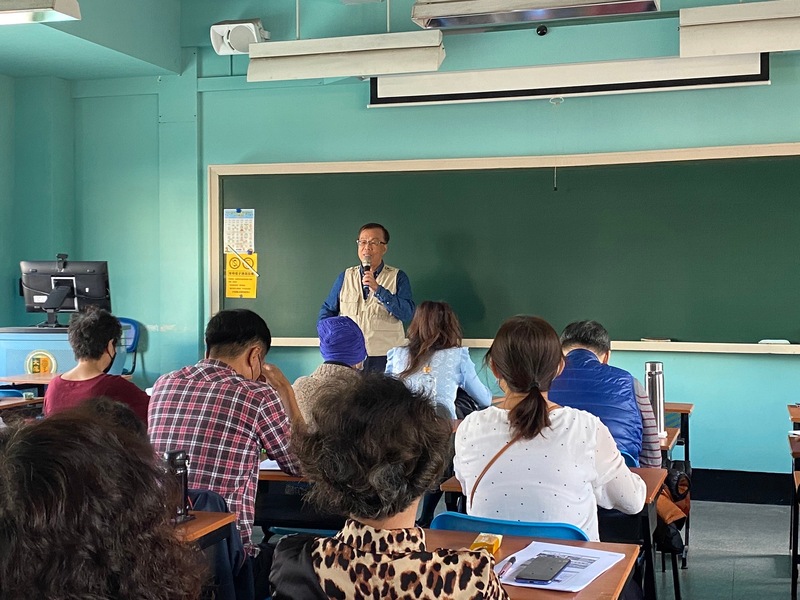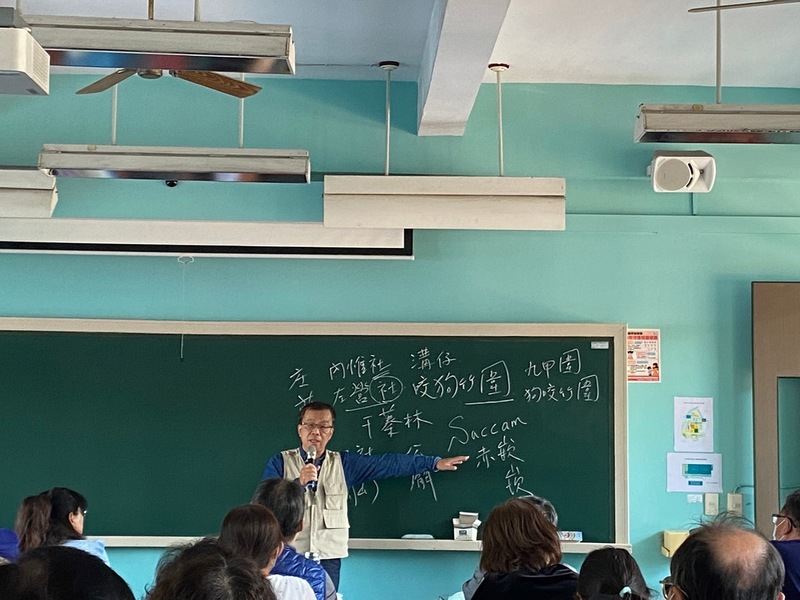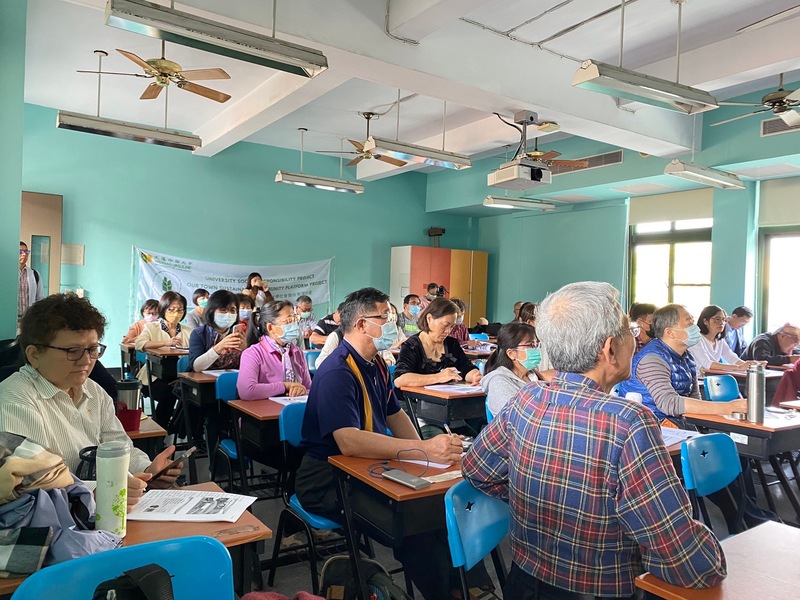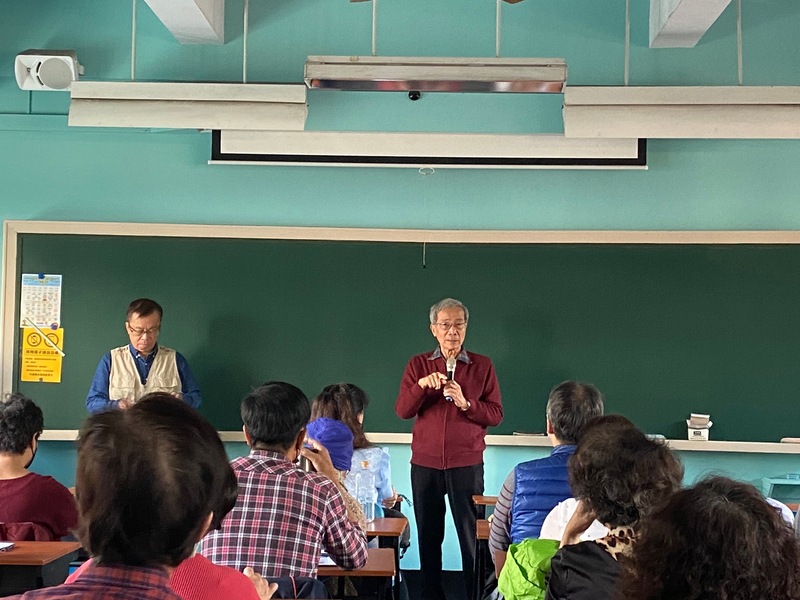【OUR TOWN學生團隊成員 林亭妤報導】
文藻外語大學大學社會責任實踐計畫─「OUR TOWN 社區永續跨域共創平台計畫」的五項社群活動,其中的「文史創新社群」於2月17日舉辦新年度的第一場講座,邀請左營在地文史研究者、舊城文化協會理事長郭吉清老師蒞臨本校,為參與者解說高雄曹公圳的故事,其內容包含開鑿緣由、灌溉面積、延伸河段、以及面臨存廢問題等等。透過本次講座,學員們跟著郭老師的腳步,一同回到180年前,窺探曹公圳的前世今生。
Wenzao Ursuline University of Languages' University Social Responsibility Practice Program, "OUR TOWN Community Sustainable Cross-Domain Collaborative Platform Project" includes five community activities. Among these, the "Culture and History Innovative Community" organized its first lecture of the new year on February 17th. The community invited local cultural and historical researcher and chairman of Kaohsiung Cultural Association, Professor Guo Jiqing, to visit our school. Professor Guo explained the story of Kaohsiung's Cao Gong Irrigation Channel, covering its reasons for excavation, irrigated area, extended river section, and also the problems such as preservation and disposal needed to face.Through this lecture, participants followed Professor Guo's footsteps to travel back 180 years and explore the past and present of the Cao Gong Irrigation Channel.
首先,郭老師將自身化為曹公圳的發想人-清代鳳山知縣曹謹,以他當時所設處的角度,為參與者娓娓道來這段豐富歷史故事。「曹公圳」,這條高雄人都耳熟能詳的一條圳道,生活中隨處可見,卻鮮少人了解其背後的存在原因以及它的歷史價值。事實上,曹公圳的身份及地位皆不容小覷。在清道光年間(西元1837年),當時鳳山縣,乃至整個南高雄平原都適逢嚴重旱災,農民生活苦不堪言之下,知縣曹謹便想到下淡水溪(現高屏溪)擁有豐沛的水量,可利用此處作為水源,建造水圳來灌溉農田。因此現今便有了「曹公舊圳」與「曹公新圳」兩大主要系統,以解決南、北高雄用水問題。而後來分支出「鳳山圳」;日治時期所建之「大寮圳」;光復後開築之「林園圳」,都為高雄水利奠定了極重要的基礎。
Firstly, Professor Guo transformed himself into the visionary behind the Cao Gong Irrigation Channel - Cao Jin, the Fengshan Magistrate during the Qing Dynasty. From his perspective at that time, he eloquently narrated this rich historical story to the participants. "Cao Gong Irrigation Channel," a well-known waterway in Kaohsiung, is ubiquitous in daily life, yet few people understand the reasons behind its existence and its historical significance. In reality, the identity and status of the Cao Gong Irrigation Channel are not to be underestimated. During the Qing Daoguang era (in 1837 AD), Fengshan County, and the entire southern plain of Kaohsiung, faced severe drought. Faced with the unbearable living conditions of the farmers, Magistrate Cao Jin thought of the abundant water resources of Lower Tamsui River (now the Gaoping River). He envisioned using this location as a water source to construct a water channel for irrigating farmland. As a result, the two major systems, "Cao Gong Old Channel" and "Cao Gong New Channel," were established to address the water supply issues in south and north Kaohsiung. Subsequently, branches such as "Fengshan Channel," the "Daliao Channel" built during the Japanese colonial period, and the "Linyuan Channel" constructed after Taiwan’s Restoration, all played a crucial role in laying the foundation for water resources in Kaohsiung.
此外,郭老師也大略向大家介紹曹公圳部分遺跡的建築特色,其中舊圳的制水門,其具備五個進水孔,因此又被稱作為「五孔涵」,為一座五孔水閘門。是當時曹謹利用五個涵洞,以磚砌的拱圈來控制進水量;另ㄧ個值得一提的是,閘門底部船首形的台階除為了減少水流衝擊之外,也可作為人員操作的平台,例如搬運等。像這樣的小道知識,我們可知原來一個水圳工程需要考量許多外在環境條件,進而打造符合時地的建築。
Additionally, Professor Guo briefly introduced the architectural features of some remnants of the Cao Gong Irrigation Channel. One notable structure is the water control gate of the old channel, known as the "Five-Hole Culvert" due to its five water inlet holes. At that time, Cao Jin used the five culverts, with brick-built arches, to regulate the inflow of water. Another noteworthy aspect is the boat-shaped steps at the bottom of the gate. Besides reducing the impact of water flow, these steps also served as a platform for personnel operations, such as handling items. Insights into such details reveal that a water channel project required consideration of various external environmental conditions to create a structure that aligns with the time and place.
最後,不免要提到「存與廢」等相關議題,郭老師提及只要是老舊建築都會面臨是否需要保存與拆遷問題。現今曹公圳的重要地位已不復如前,許多原流經高雄市區的水圳路線,至今已變為現代化地下管線。甚至有些竟成為家家戶戶亂丟廢棄物的骯髒水溝;以及原本的六孔制水門因影響附近居民的財產安全,於2006年間便遭到拆除。以上等等現象都揭示了「曹公圳」正一點一滴消逝在大眾的視野裡。雖說目前有針對曹公圳及愛河做了維護與整治,但文化保存部分仍須透過政府、文史研究專家及市民的一同努力,重視這不單單只是一項偉大建設,也是孕育高雄人文、經濟發展的搖籃。我們也期盼透過本次講座,使參與者多關注身旁環境中的既有建築,並思考它們的價值與保存方式,不讓其默默消失於歷史當中。
Finally, it is inevitable to touch upon issues related to "preservation and abandonment." Professor Guo mentioned that any old building inevitably faces the dilemma of whether to be preserved or demolished. The significance of the Cao Gong Irrigation Channel has diminished in the present day, with many original water channels that once flowed through the urban areas of Kaohsiung now transformed into modern underground pipelines. Some have even become dirty drains where households dispose of waste indiscriminately. The original six-hole water control gate, due to concerns about nearby residents' property safety, was dismantled in 2006. All these phenomena reveal that the Cao Gong Irrigation Channel is gradually fading from public view. While there have been efforts to maintain and remediate the Cao Gong Irrigation Channel and Love River, the cultural preservation aspect requires collective efforts from the government, cultural and historical research experts, and the citizens. It should be recognized not just as a significant construction project but also as the cradle nurturing Kaohsiung's culture and economic development. Through this lecture, we hope participants will pay more attention to existing structures in their surroundings, contemplating their value and preservation methods, preventing them from silently disappearing into history.
新年度的第一場講座活動圓滿落幕,本次主題與以往較不同,不只是介紹單一建築,而是影響整個高雄平原地區的灌溉系統。讓參與夥伴除收穫文史養分外,也可思考「水利設計工程」、「兼顧環境與文化保存」等多方面議題。「OUR TOWN 社區永續跨域共創平台計畫」會繼續與在地社區密切合作、規劃豐富講座內容,並持續尋找適合分享在地文史的學者,為大家介紹更多人文歷史,讓所有參與者更能了解自己生長的地方,一起為在地社區付出一份心力。
The first lecture of the new year concluded successfully. Unlike previous sessions that focused on individual buildings, this time the theme centered around an irrigation system that influences the entire Kaohsiung plain area. Participants not only gained insights into cultural and historical aspects but also had the opportunity to contemplate various issues such as "water engineering design" and "balancing environmental and cultural preservation. "OUR TOWN Community Sustainable Cross-Domain Collaborative Platform Project," will continue to collaborate closely with the local community, plan engaging lecture topics, and actively seek scholars knowledgeable in local culture and history. By introducing more aspects of humanities and history, we aim to deepen the understanding of the participants about the place they grew up in. Together, we strive to contribute our efforts to the local community.

文史研究員郭吉清老師開場引言(林亭妤 攝影)
Opening remarks by Research Fellow Guo Jiqing

郭吉清老師介紹曹公圳歷史故事(林亭妤 攝影)
Introduction by Professor Guo Jiqing on the historical story of Cao Gongzun

參與者仔細聆聽講座內容,並於講義中紀錄重點(林亭妤 攝影)
Participants listen carefully to the lecture content and record key points in the handout

參與夥伴意見發表(林亭妤 攝影)
Expression of opinions by participating partners
